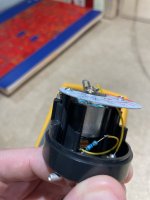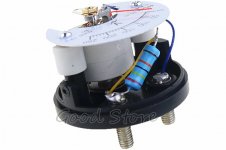Looking for a back mounted analog voltmeter for a tube build I’m working on.
I’d like it to display bias voltage which is 40mA or 40mV when measured across the 1R cathode bias sensing resistors.
I could make the voltage 400mV with a 10R cathode bias sensing resistors.
Where can I buy an analog back panel mounted voltmeter, either 0-100mV or 0-500mV?
I’d like it to display bias voltage which is 40mA or 40mV when measured across the 1R cathode bias sensing resistors.
I could make the voltage 400mV with a 10R cathode bias sensing resistors.
Where can I buy an analog back panel mounted voltmeter, either 0-100mV or 0-500mV?
Seems like I found it
https://www.ebay.ca/itm/18572131170...XYDFGH1sphhdm2PObWYsZElutw==|tkp:BFBMlsaw7rhh
https://www.ebay.ca/itm/18572131170...XYDFGH1sphhdm2PObWYsZElutw==|tkp:BFBMlsaw7rhh
Buy three. When I buy meters in that price class in that market, about 1 in 4 has "problem". On a LCD meter it was a bad backlight, made it hard to read. You may not have backlight but defects happen, and at that price the sellers don't care. I ordered two spares, meanwhile re-soldered a bad wire, and I may be set for life. Spending $13 for idle spares is better than not spending $13 and meters dying over time. (It's not the cost but the days of cutting and filing a hole....)I found it
Ok the meters arrived from China today. I feel stupid but I can't get them to work....
I set my benchtop PSU to 4V
I put together a 4K7 + 47R voltage divider. I measured across the 47R and I get 0.04V on my Fluke DMM.
I clip the new analog meter across the 47R and it barely moves the needle (moves from 0 to 2mV). Does not read 40mV on its little panel.
Am I missing something or are these meters DOA????
I set my benchtop PSU to 4V
I put together a 4K7 + 47R voltage divider. I measured across the 47R and I get 0.04V on my Fluke DMM.
I clip the new analog meter across the 47R and it barely moves the needle (moves from 0 to 2mV). Does not read 40mV on its little panel.
Am I missing something or are these meters DOA????
Clip the meter AND the fluke across the 47r & see if they read the same.
The meter may be loading your voltage divider.
Measure the current drawn by the meter at full scale.
The meter may be loading your voltage divider.
Measure the current drawn by the meter at full scale.
Well, technically, if you replace 1 ohm with 1.5ohm cathode resistor, with the meter in parallel you would be back at 1ohm.
My point about the analog meters measuring 3 ohms was that aren’t voltmeters supposed to be high impedance devices? They are placed in parallel in circuits, you want high impedance so they don’t load down a circuit.
When I place the analog meter and Fluke DMM across the 47 ohm resistor I get no reading on the Fluke DMM.
I’m guessing the analog meter being 3 ohms is essentially shorting out the 47 ohm resistor. Not going to measure much voltage across a short….
When I place the analog meter and Fluke DMM across the 47 ohm resistor I get no reading on the Fluke DMM.
I’m guessing the analog meter being 3 ohms is essentially shorting out the 47 ohm resistor. Not going to measure much voltage across a short….
Yes.
Old analogue DMMs used to be 20,000 Ohms per Volt.
100mA range would be 2000Ohms impedance.
I wouldn't expect a panel meter to be quite as good.
As you've nothing to loose, can you get inside one & see if there is a shunt that you can mess with?
Old analogue DMMs used to be 20,000 Ohms per Volt.
100mA range would be 2000Ohms impedance.
I wouldn't expect a panel meter to be quite as good.
As you've nothing to loose, can you get inside one & see if there is a shunt that you can mess with?
This type of analog meters are a current meter (milli- or microampere range) with a series resistor when used as voltmeter, a parallel shunt for the amperometer, or a diode/resistor for the vu-meter. It is easy to remove the resistor and use an external one according to the application. The built-in resistor is not a precision part anyway and may even be the wrong type. After removing the resistor, a protection diode may be added between the terminals if required.
Attachments
Based on the 1mA rule for full scale I added a 47R resistor
50mV/1mA = 50R
Even with a 47R resistor in series with the meter a 40mV voltage as measured by my Fluke DMM only appeared as 20mV on the analog meter. The eBay seller has already refunded me.
50mV/1mA = 50R
Even with a 47R resistor in series with the meter a 40mV voltage as measured by my Fluke DMM only appeared as 20mV on the analog meter. The eBay seller has already refunded me.
brown , black, black.....brown
10R 1%.
Is your intention to leave the meters in circuit or switch in when biasing?
10R 1%.
Is your intention to leave the meters in circuit or switch in when biasing?
My intention was to have one analog meter on the amp. One lead connecting to ground. The other lead going to a 4 way rotary switch. The switch allowing me to select one of the power tubes cathodes.
The idea being I can turn the switch and get the power tubes bias readings displayed on the meter.
The idea being I can turn the switch and get the power tubes bias readings displayed on the meter.
fair enough.
Adjust resistor, calibrating against the fluke. Both meter & DMM connected at same time to eliminate voltage variance due to meter loading effect.
Calculate if the meter will have significant loading effect on the cathode reading - ie meter resistance compared to 10R cathode resistor.
Assuming 4 valves, use 5 position switch - position 5 meter out of circuit.
Adjust resistor, calibrating against the fluke. Both meter & DMM connected at same time to eliminate voltage variance due to meter loading effect.
Calculate if the meter will have significant loading effect on the cathode reading - ie meter resistance compared to 10R cathode resistor.
Assuming 4 valves, use 5 position switch - position 5 meter out of circuit.
russc, I am starting to wonder now...
I have four meters, none seem to read very well.
They all have tiny impedance (<10R). I am trying to measure voltage across a 1R cathode resistor with 40mA of current flowing through it. I am wondering if these measurements are all too small.
I have four meters, none seem to read very well.
They all have tiny impedance (<10R). I am trying to measure voltage across a 1R cathode resistor with 40mA of current flowing through it. I am wondering if these measurements are all too small.
- Home
- Design & Build
- Parts
- Where to find (back) panel mounted voltmeter?

